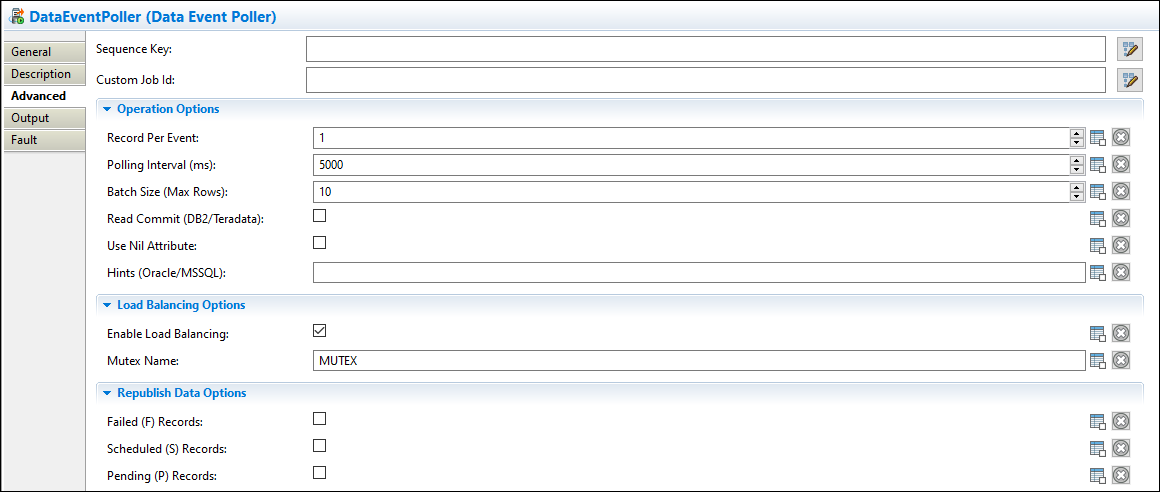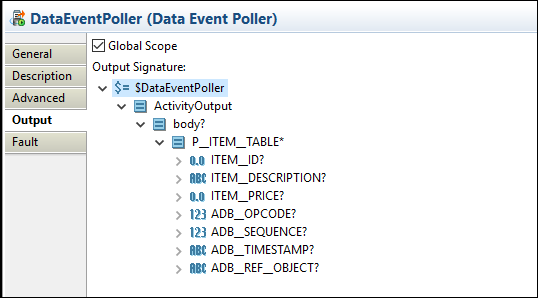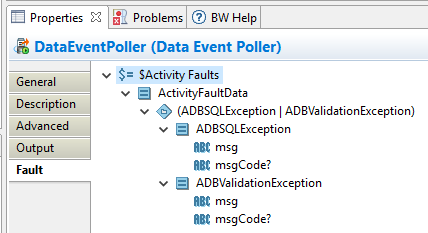Data Event Poller Activity
The Data Event Poller activity polls the change in a stage table in a specified time interval. The configuration allows you to generate the required trigger SQL script file to create stage table and triggers.
General
The General tab has the following fields:
Advanced
This tab has the following fields:
| Field | Literal Value/Process Property/Module Property? | Description |
|---|---|---|
| Sequence Key | No | This field can contain an XPath expression that specifies the processes that must run in order. Process instances with sequencing keys that evaluate to the same value are executed sequentially in the order the process instance was created. |
| Custom Job ID | No | This field can contain an XPath expression that specifies a custom ID for the process instance. |
| Operation Options | ||
| Record Per Event | Yes | Specifies the maximum number of database records to be retrieved per event to start a ActiveMatrix BusinessWorks job. The default value is 1. |
| Polling Interval (ms) | Yes | Specifies the amount of time in milliseconds for polling.
Default: 5000ms. |
| Batch Size (Max Rows) | Yes | Maximum number of records to be retrieved for each polling, when polling batch is used.
Default: 10. |
| Read Commit (DB2/Teradata) | Yes |
Enables the plug-in publisher to perform a commit operation after selecting a query for DB2. This check box is enabled only when you use DB2 database vendors, including DB2 OS390, DB2 AS400, and DB2 UDB. |
| Use Nil Attribute | Yes | When set to true, the column whose value is null is shown as nil attribute in the activity output.
When set to false, the column whose value is null is not shown in the activity output. |
| Hints (Oracle/MSSQL) | Yes | Hints help improve the performance of your queries.
When Data Event Poller activity executes a poll operation to fetch data from a table, using hints greatly enhances the performance. |
| Load Balancing Options | ||
| Enable Load Balancing | Yes |
Load balancing distributes the workload across ActiveMatrix BusinessWorks Application nodes to improve the performance in a high-load scenario. ActiveMatrix BusinessWorks Application nodes with the same mutex name are in the same load balance group. Load balancing is enabled by default. |
| Mutex Name | Yes | Name of the Mutex table. This name can be changed.
The default name is the first 20 characters of the publishing table name suffixed with "_MUTEX". |
| Republish Data Options | ||
| Failed (F) Records | Yes | If this check box is selected, records that have a failed status are republished when the application is started. |
| Scheduled (S) Records | Yes | If this check box is selected, records that have a scheduled status are republished when the application is started. |
| Pending (P) Records | Yes | If this check box is selected, records that have a pending status are republished when the application is started. |
| Schema Mapping Options | ||
| Design Time | Yes | Specifies the design-time database object's schema. It can be a list of comma-separated schemas. |
| Runtime | Yes | Specifies the runtime table object's schema. It can be a comma-separated list of schemas. |
Output
This tab displays the output schema.
For more information about how different data types are mapped to the XSD type, see Output Mapping.
Fault
| Error Schema Element | Data Type | Description |
|---|---|---|
| ADBSQLException | String |
It has a msg and msgCode field for the exception. |
| ADBValidationExeption | String |
It has a msg and msgCode field for the exception. |
| msg | String | The error message returned by the plug-in. |
| msgCode | String | The error code returned by the plug-in. |




